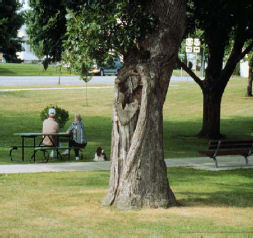Early fall produced several severe storms with high winds ranging from 70 to 90 mph’s, creating havoc with the trees in our neighborhoods. Much of the property damage was caused by trees, trees that were already under stress whether from biological or physical; physical stress such as decay, included bark, or inclusions, biological ways such as drought, water stress or poor soil conditions.
Tree Risk AssessmentCountless trees are hazardous of which property owners may be unaware because the tree can look healthy but in fact could harbor many of the physical and biological defects mentioned. With the right storm, ice loads, high winds, etc. the tree could come falling down on a home, person, car, into or onto a well-traveled area.

Now that winter is upon us, it is a good time to inspect trees because of the lack of foliage. A Certified Arborist can inspect for defects, inclusions, old wounds that get compartmentalized, cross over limbs, cavities and it’s a good time to remove mistletoe. (DOA Forest Service – How to recognize…)
While the experienced arborists can make judgments based on the visual tree inspection, there’s really no need to take risk of not knowing what exactly is going on inside the tree itself. By adding new capabilities, specifically the Resistograph, this allows the arborists to take a scientific approach to helping property owners determine if they have a hazardous tree that needs to be removed. The output of the Resistograph can also guide clients to whether they want to spend money on the tree by installing bracing rods, cables, or other tried-and-true methods of technology that ensure minimal invasion, and maximum support to a tree’s weaker limbs. (What is a Resistograph?)
By calling Julie Odum to schedule a tree risk assessment (TRA) you can reduce the possibility of tree hazards, and increase the safety of the area around the tree. Call us today to set up your free TRA and gain the peace of mind that you deserve.
.jpg)